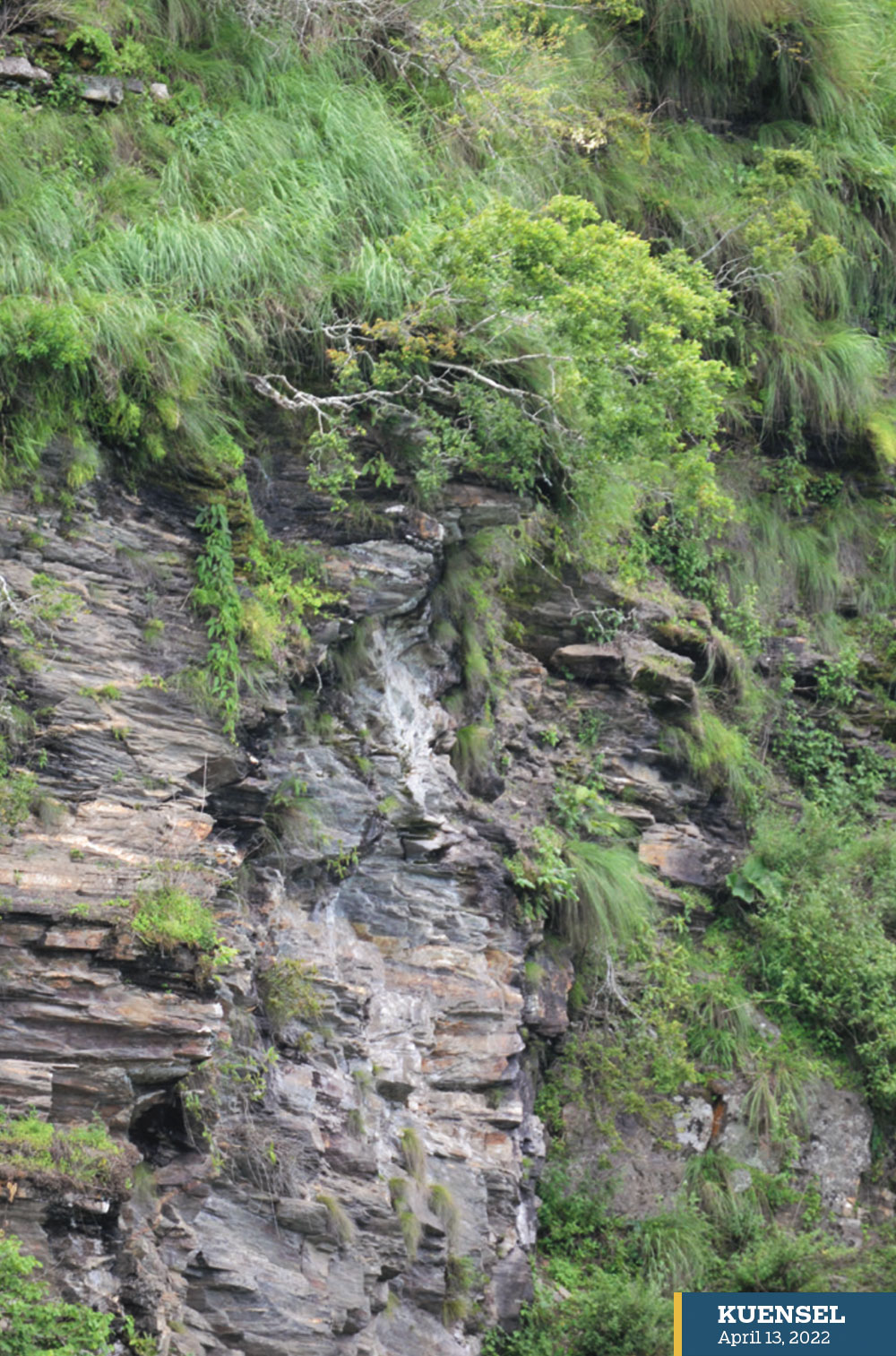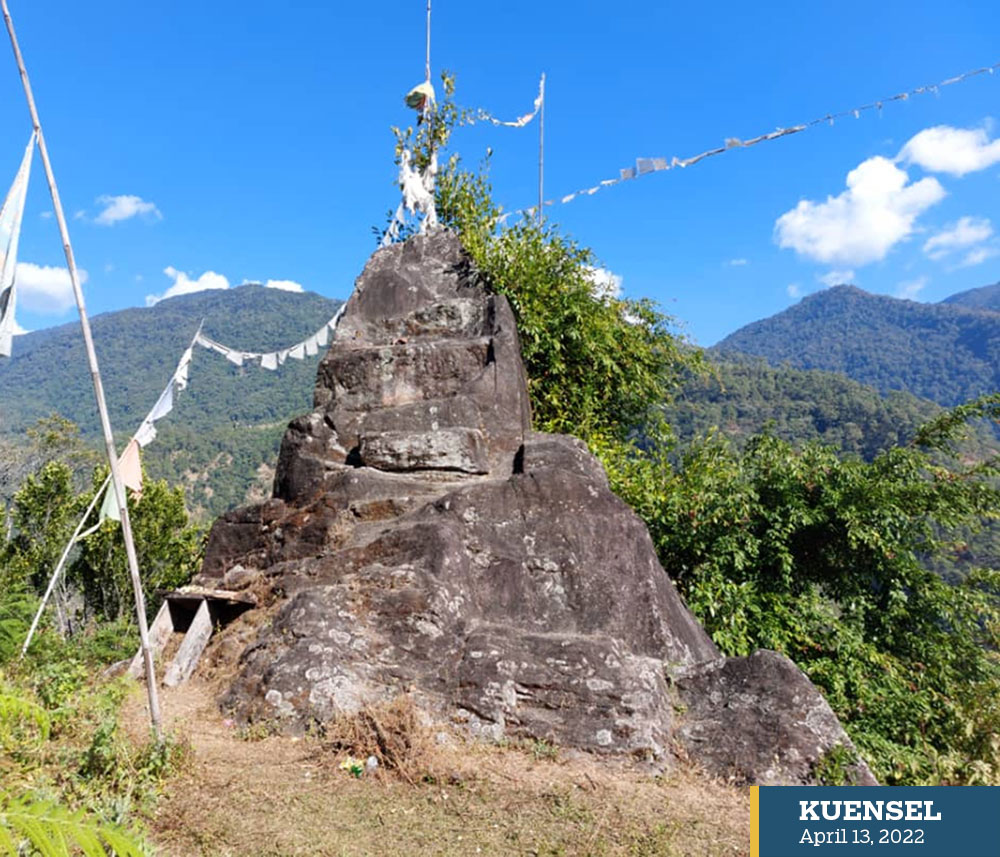Choki Wangmo | Dagana
Dagana—According to local beliefs, the name is derived from the presence of many stone monoliths and pillars in the dzongkhag. The three-sister pillars, believed to be siblings, are positioned on different locations as part of a larger tripod across gewogs in the dzongkhag.
Located in Kana and Lajab gewogs, the pillars—Do Namkhai Kaw, Tha Namkhai Dzong, and Do Kelpai Goenthem—are popularly known for their rich spiritual and historical connections with the local people.
At about two hour’s walk from Nindukha in Kana gewog, 20-metre-high Do Namkhai Kaw (The Sky Pillar Rock), believed to contain 1,000 Buddha statues, is said to have flown from India.
“Tradition has it that when the monolith landed on the present site, nearby trees and rocks bowed in respect,” says the monograph: On the Mule Track to Dagana, by Dorji Penjore.
Considered to be as holy as the Maha Bodhi Temple in Bodh Gaya, India, the pinnacle of the monolith, which is at the same height with the Dagana Dzong, has a 16-cm-long footprint of a dakini.
Locals belief that on auspicious days, fortunate beings can hear the sound of ritual instruments and prayers from inside the huge rock.
According to a legend, the monolith spoke during the construction of the Danaga Dzong warning that the dzong would collapse if it was built any taller than the pillar. Today the dzong’s sertho and the pillar are of the same height.
Although the nearby areas at the site are covered in thickets, monks are believed to have stayed in retreats in the area in the past. Due to the blessings from the pillar, it is believed that the size of Dagana dratshang increased considerably and most monks became highly accomplished.
At the same height as Do Namkhai Kaw, the second pillar is located at Tanabji in Kana which is a 30-minute walk from below the secondary national highway. Dho Kelpai Goenthem (The Ancient Rock Step) is a self-arisen rock with a flight of five steps, one step buried underground.

Do Namkhai Kaw
Local people believe that when these four steps also sink, the current era would come to an end. Climbing these steps, however, is considered virtuous and cleanses one’s defilements.
In the Sacred Monasteries and Religious Sites of Bhutan (2008), it is said that a monk, who went with his two other friends to make prayers at the site offered a female hog and its seven piglets to the lady deity of the area. She refused the offering, saying that the monk was poor. This hurt the monks’ feelings, and through their powers turned the hog and the seven piglets into stones. “People believe that the pig feeding its piglets can be still seen in a deep ravine adjacent to the monolith. The ravine is known as Phagmoi Ney.”
The third stone pillar, Tha Namkhai Dzong, located in Lajab gewog, is considered the hidden site of Guru Rinpoche, and locals consider it as sacred and famous as the Taktshang in Paro. Essential Guide to Sacred Sites, Dagana, says that a bell could be seen hanging down from the cliff. Above the bell, one can also see an urn. “The clapper of the bell can be seen like a leaf of Bodhi tree.” A sound of the bell can be heard when the wind hits the clapper.

Tha Namkhai Dzong
It is stated that the bell could be a treasure and the rock unto which the bell is hanging resembles a frog.
From the valley floor, the cliff where a cave is located looks as if it is suspended in air. No human or animal can enter the cave.
A monk in Daga Dzong, Kado, said that a legend says that a fortunate cow herder from the village mistakenly entered the cave while looking for his cattle. It is said that he attended a feast with celestial beings who told him not to reveal the dzong to other people.
After coming out from the cave, the man, who lost track of time and place, to his surprise discovered that already three generations had passed.
Kado said that in recent years, a man from the village tried to climb and enter the cave but midway, he couldn’t climb. Thereafter, misfortunes befell on the man and his life changed for the worst.
Down from Tha Namkhai Dzong, there is a place called Zhabjethang, named after a footprint left by Guru Rinpoche. To the north-west of Zhabjethang, there is a body print of seven dakinis believed to have left when they were prostrating to a box that is on the left side of Tha Namkhai Dzong.
Every year, on the 10th day of the second month of the traditional calendar, Tanabji people conduct a tshechu.
Ruins of retreat houses can be seen in the area.


